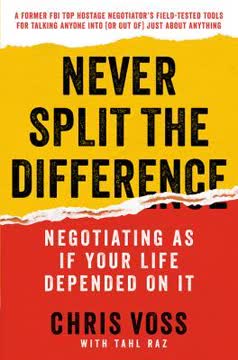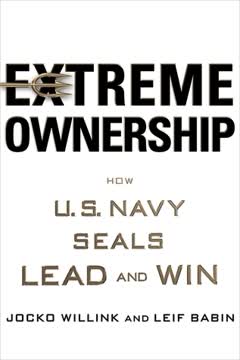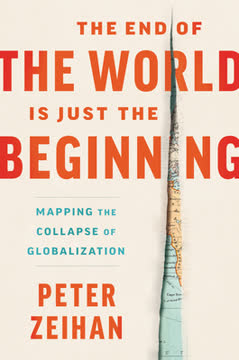Key Takeaways
1. Articulate Your Leadership Philosophy on One Page
Imagine being able to explain your leadership philosophy on one piece of paper—a simple 8.5- by 11-inch summation of all you are and all you want to be as a leader.
Powerful tool for clarity. The Leadership Maxims approach helps you distill your leadership philosophy into 15-20 emotionally powerful statements that fit on a single page. This concise format forces you to focus on what truly matters in your leadership style and makes it easy to communicate your expectations to your team.
Authenticity is key. Your maxims should be deeply personal, free of corporate jargon, and rooted in your own experiences. They serve as daily reminders of how you want to behave and lead, acting as your leadership conscience. By sharing these maxims and the stories behind them, you build trust and understanding with your team.
Four aspects of leadership. The approach covers:
- Leading yourself
- Leading the thinking
- Leading your people
- Leading a balanced life
2. Lead Yourself First: Define Your Motivation and Future Vision
If you are unable to inspire yourself, how can you expect to inspire your people?
Know your "why". Reflect on what truly motivates you and why you get out of bed every day. This understanding will help you align your work with your passions and make better career decisions. For example, the author's maxim "Light bulbs" reminds him of his passion for teaching and seeing understanding dawn in others.
Define your future self. Create a clear vision of who you want to become, regardless of external circumstances. This aspirational self-image will guide your decisions and actions. Consider what you want your epitaph to say or how you want to be remembered.
Establish personal guidelines. Develop maxims that remind you of your ethical boundaries and non-negotiables. These will help you make difficult decisions under pressure and maintain your integrity.
3. Set Clear Standards and Expectations for Your Team
A cadet will not lie, cheat, or steal nor tolerate those who do.
Articulate your values. Clearly define the standards you expect your team to uphold. These can be internally focused (like the West Point honor code) or externally focused (like customer service standards). Make sure these standards align with your personal values and the organization's goals.
Communicate expectations. Share your maxims with your team to provide clarity on how you want them to behave. This reduces confusion and helps your team focus on what's important. For example, the maxim "Is this right for the customer?" provides a clear decision-making framework.
Lead by example. Consistently demonstrate the standards you set. When you fail to meet your own standards, acknowledge it and use it as a learning opportunity for yourself and your team.
4. Challenge the Status Quo and Drive Action
In case of doubt, attack!
Question assumptions. Develop maxims that remind you to regularly challenge the status quo and look for new opportunities. The author's "Why? Why? Why? Why? Why?" maxim encourages deeper exploration of issues and assumptions.
Look to the future. Create a compelling vision for your organization and communicate it clearly. A well-crafted vision statement should inspire your team and provide direction for decision-making.
Drive action. Balance analysis with action. Develop maxims that push you to make decisions and move forward, even in uncertain situations. Remember that inaction is still a choice, and often a costly one.
5. Treat Your Team Members as Unique Individuals
He drinks 7UP.
Know your people. Make an effort to learn about your team members' personal lives, interests, and aspirations. This knowledge helps you build stronger relationships and tailor your leadership approach to each individual.
Show you care. Small gestures that demonstrate your attention to personal details can have a big impact on motivation and loyalty. The author's "7UP" story illustrates how a simple act of remembering a preference dramatically improved a soldier's performance.
Listen more than you talk. The maxim "You have two ears and one mouth for a reason" serves as a reminder to focus on understanding others rather than dominating conversations.
6. Stay Connected to Your Team's Reality
He's under the tank, sir.
Get your hands dirty. Regularly engage in the work your team does to understand their challenges and maintain credibility. The author's story of working on tank maintenance illustrates how this approach can earn respect and build rapport.
Avoid ivory tower syndrome. Create maxims that remind you to stay grounded in the day-to-day realities of your organization. This helps you make more informed decisions and avoid unrealistic expectations.
Seek understanding. When you don't understand an aspect of your team's work, ask questions and learn. Admitting ignorance and seeking knowledge demonstrates humility and a commitment to continuous learning.
7. Commit to Your People's Growth and Development
But he's never done that job!
Take calculated risks. Be willing to put team members in stretch roles to help them grow. The author's story of promoting Carson illustrates how taking a chance on someone can lead to great results and increased loyalty.
Provide timely feedback. Develop maxims that remind you to address performance issues promptly. The author's maxim "It's easier to correct course 100 yards into the journey than 100 miles into it" emphasizes the importance of early intervention.
Create growth opportunities. Consistently look for ways to challenge your team members and help them develop new skills. This not only improves individual performance but also builds bench strength for your organization.
8. Establish Boundaries for Work-Life Balance
Fred Flintstone
Define your limits. Clearly articulate the boundaries you need to maintain a healthy work-life balance. This includes the type of work you do, how you prefer to work, and when you work.
Communicate your boundaries. Share your maxims with your team and colleagues to set clear expectations. For example, the author's "I'm going home. You're doing my job." maxim clearly communicates his stance on micromanagement.
Stick to your guns. Once you've established boundaries, be consistent in enforcing them. Use your maxims as reminders to maintain balance, even when work pressures mount.
9. Keep Perspective in Stressful Situations
Burger King is hiring.
Develop grounding techniques. Create maxims that help you regain perspective when stress threatens to overwhelm you. The author's "Burger King is hiring" and "A Burger King crown" maxims serve as reminders not to take things too seriously.
Contextualize problems. Use phrases like "It's only [blank]" to put stressful situations into perspective. This helps you and your team avoid overreacting to minor issues.
Model calmness. Your ability to maintain composure under pressure sets the tone for your team. Develop maxims that remind you to stay calm and focused during crises.
10. Pursue Your Passions Outside of Work
A bad day of fishing is better than a good day of work.
Make time for what matters. Develop maxims that remind you to prioritize your passions and relationships outside of work. The author's fishing maxim serves as a constant reminder to balance work with life's pleasures.
Remember why you work. Create maxims that connect your work to your life goals. For example, "Work buys adrenaline" reminds one executive that his job enables his passion for adventure sports.
Live in the present. Avoid the trap of always postponing enjoyment. Remember, "Someday is not a day of the week." Use your maxims to motivate yourself to pursue your passions now, rather than waiting for retirement or some future date.
Last updated:
FAQ
What's One Piece of Paper about?
- Leadership Philosophy Simplified: One Piece of Paper by Mike Figliuolo focuses on creating a personal leadership philosophy that can be summarized on a single page. It emphasizes defining leadership maxims that guide behavior and decision-making.
- Four Aspects of Leadership: The book outlines four key areas: leading yourself, leading the thinking, leading your people, and leading a balanced life. Each aspect is crucial for developing a comprehensive leadership style.
- Practical Application: Figliuolo provides actionable steps for readers to create their own maxims, encouraging introspection and personal growth. This approach fosters authenticity and clarity in leadership.
Why should I read One Piece of Paper?
- Personal Development Focus: Ideal for enhancing leadership skills and self-awareness, the book encourages reflection on motivations and values, leading to personal growth.
- Clear Framework: Offers a structured method for developing a leadership philosophy, making it accessible for leaders at all levels. The simplicity of the one-page approach is easy to implement.
- Real-World Examples: Figliuolo shares personal anecdotes and examples from his experience, providing relatable insights into effective leadership practices.
What are the key takeaways of One Piece of Paper?
- Create Your Maxims: Readers are encouraged to develop 15-20 emotionally powerful statements that guide their behavior as leaders, serving as a personal leadership conscience.
- Holistic Leadership Approach: Emphasizes a comprehensive view of leadership, including self-awareness, team dynamics, and work-life balance, ensuring effectiveness in all areas of life.
- Continuous Improvement: Stresses the need for ongoing reflection and adaptation of maxims as leaders grow and face new challenges, crucial for long-term success.
What is the Leadership Maxims Approach in One Piece of Paper?
- Definition of Maxims: A maxim is a principle or rule of conduct reflecting personal beliefs about leadership. They should be simple, clear, and devoid of corporate jargon.
- Personal Meaning: Maxims must resonate emotionally with the leader, drawing from personal experiences and values, increasing the likelihood of behavior change.
- Application in Leadership: Encourages leaders to articulate their philosophies in a way that builds trust and clarity within their teams, reducing confusion about expectations and standards.
How do I create my own leadership maxims from One Piece of Paper?
- Self-Reflection: Engage in introspection to identify core values, beliefs, and experiences shaping your leadership style. Consider what you want to stand for as a leader.
- Answer Key Questions: Figliuolo provides questions to guide your thinking, such as “What is your natural style?” and “How will you commit to your people’s growth?”
- Synthesize Themes: Look for recurring themes or powerful stories that resonate with you. Use these insights to craft maxims that are personal, memorable, and actionable.
What are the four aspects of leadership discussed in One Piece of Paper?
- Leading Yourself: Focuses on self-awareness, personal values, and setting standards for oneself, emphasizing understanding what motivates you.
- Leading the Thinking: Involves challenging the status quo and encouraging innovative thinking within teams, fostering a culture of creativity.
- Leading Your People: About understanding and supporting team members as individuals, emphasizing building relationships and treating team members with respect.
- Leading a Balanced Life: Stresses the need for leaders to maintain balance in personal and professional lives, essential for long-term effectiveness and well-being.
How can I apply the concepts from One Piece of Paper in my daily life?
- Daily Reflection: Set aside time each day to reflect on your leadership maxims and how they apply to current challenges, reinforcing commitment to values.
- Accountability: Share your maxims with your team and encourage them to hold you accountable, fostering trust and creating a shared understanding of expectations.
- Regular Review: Periodically revisit your maxims to assess their relevance and effectiveness, being open to refining them as you grow and face new challenges.
What are some examples of effective maxims from One Piece of Paper?
- "In God we trust. All others bring data.": Emphasizes data-driven decision-making, encouraging team members to support ideas with evidence.
- "A cadet will not lie, cheat, or steal nor tolerate those who do.": Sets a high standard for ethical behavior, reinforcing accountability and integrity within the organization.
- "Is this right for the customer?": Focuses on customer-centric decision-making, reminding team members to prioritize customer needs in their actions.
What are the best quotes from One Piece of Paper and what do they mean?
- “In case of doubt, attack!”: Emphasizes decisiveness in leadership, suggesting that taking action is better than inaction, which can lead to stagnation.
- “You have two ears and one mouth for a reason.”: Reminds leaders to listen more than they speak, prioritizing understanding team members' perspectives and concerns.
- “A bad day of fishing is better than a good day of work.”: Highlights the importance of work-life balance and pursuing passions outside of work, encouraging personal fulfillment.
How does One Piece of Paper address the importance of feedback in leadership?
- Constructive Feedback: Emphasizes the need for leaders to provide timely and constructive feedback to team members, fostering growth and development.
- Creating a Feedback Culture: Encourages leaders to create an environment where feedback is welcomed and valued, promoting open communication and continuous improvement.
- Self-Reflection: Leaders are encouraged to seek feedback on their own performance, helping identify areas for growth and reinforcing commitment to personal development.
How does One Piece of Paper address the issue of buzzwords in leadership?
- Critique of Corporate Jargon: Highlights the prevalence of buzzwords in leadership discussions and their lack of meaning, encouraging leaders to avoid jargon.
- Emphasis on Authenticity: Advocates for leaders to express their philosophies in simple, relatable terms, helping build trust and understanding within teams.
- Clarity Over Complexity: By stripping away unnecessary jargon, leaders can communicate ideas more effectively, enabling teams to understand expectations and goals better.
How can I ensure that my leadership maxims remain relevant over time?
- Regular Evaluation: Schedule periodic reviews of your maxims to assess their effectiveness and relevance, allowing adaptation as your leadership journey evolves.
- Seek Input from Others: Share your maxims with trusted colleagues or mentors and invite their feedback, providing valuable insights for refinement.
- Embrace Change: Be open to modifying or replacing maxims that no longer resonate, ensuring they reflect your current leadership philosophy as you grow and face new challenges.
Review Summary
One Piece of Paper receives mostly positive reviews, praised for its practical approach to developing personal leadership philosophies. Readers appreciate Figliuolo's relatable writing style and the book's emphasis on self-reflection. Many found value in creating concise maxims to guide their leadership. Critics note repetitiveness and self-indulgence. The book is often used in leadership courses, with students finding it engaging and applicable. Overall, readers recommend it for those seeking to develop authentic leadership skills, though some suggest it could be more concise.
Similar Books
Download PDF
Download EPUB
.epub digital book format is ideal for reading ebooks on phones, tablets, and e-readers.









